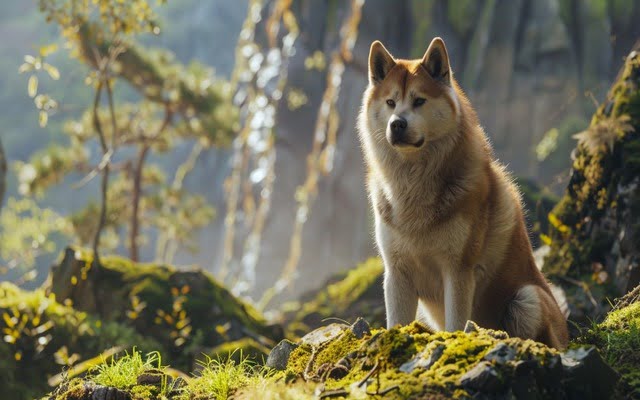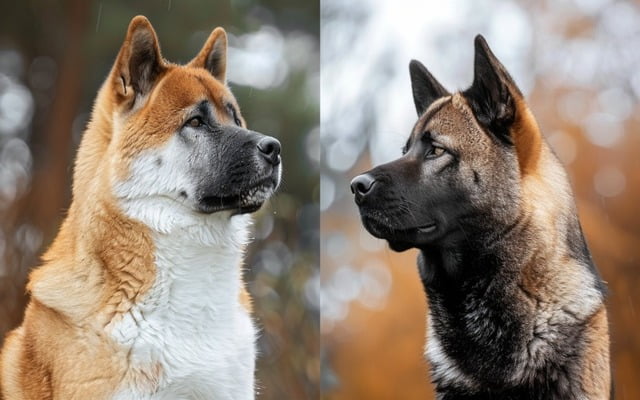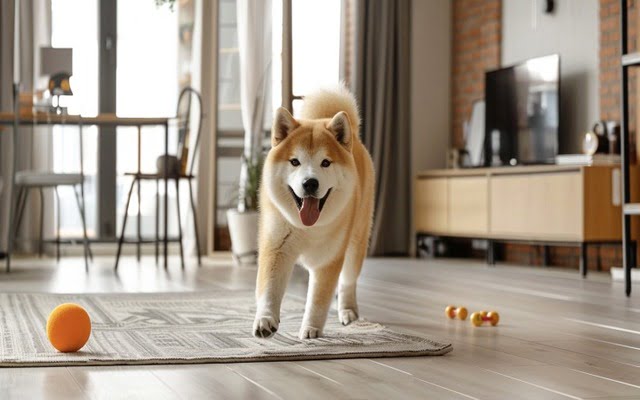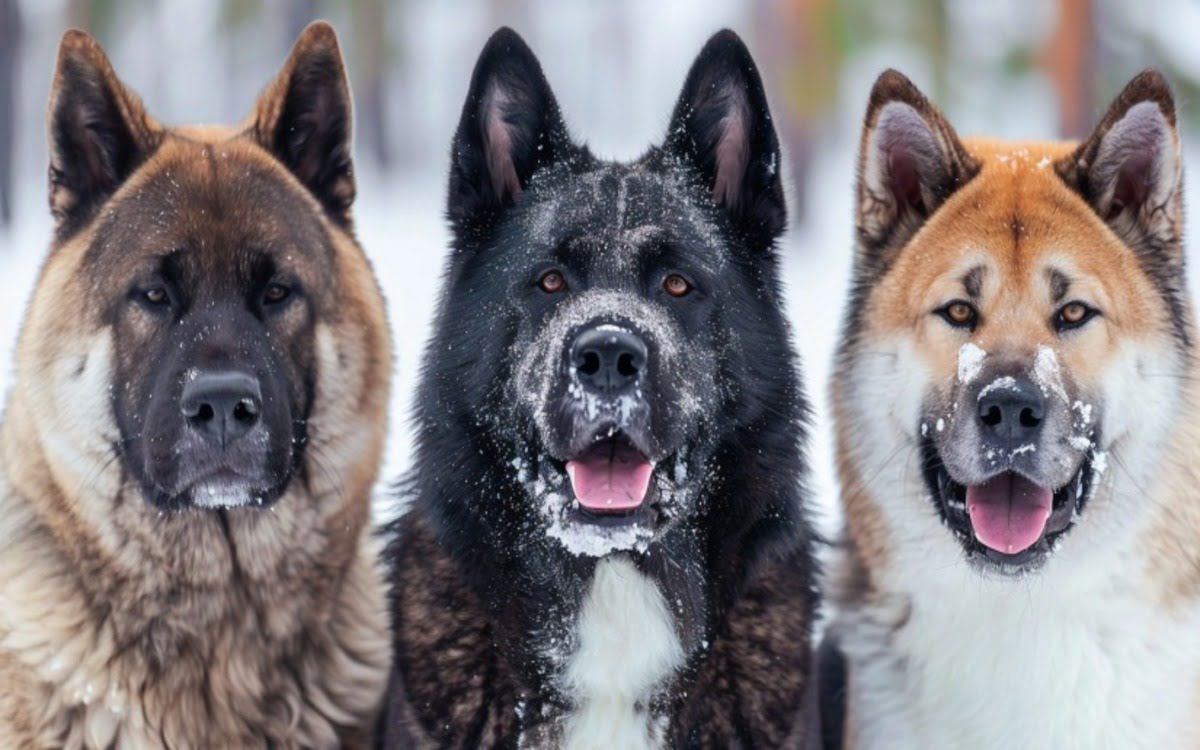Have you ever dreamt of welcoming a majestic Akita into your life? These loyal and undeniably handsome companions hail from a rich history in Japan, where they were once revered guardians. But before you embark on this exciting journey, it’s important to consider their monumental size. Akitas are not your average lapdog; they’re powerful and statuesque canines that require ample space and a dedicated owner.
Problem-Solution Approach: This comprehensive guide unravels the mysteries of Akita size. We’ll delve into the variations you can expect between the American Akita and the Japanese Akita, explore the fascinating role of genetics and nutrition in their development, and answer the burning question: How big will MY Akita get?

Understanding Akita Size Variations
Akita Spotlight: Did you know? Akitas boast a rich and fascinating history. In ancient Japan, these loyal companions served as guardians for royalty and nobility. Their double coat – plush and weather-resistant – provided protection during harsh winters, while their alert nature made them exceptional watchdogs. Today, Akitas come in two distinct breeds: the American Akita and the Japanese Akita.
American Akita vs. Japanese Akita:
- American Akita: This breed is known for its larger size and bolder facial features. Their coat comes in a wider variety of colors, including red, fawn, and brindle, with distinct white markings.
- Japanese Akita: Slightly smaller and more agile than their American counterparts, Japanese Akitas have a spitz-like facial structure and a primarily red fawn or white coat.
Size Spectrum: Even within each breed, there can be variations in size. Here’s a look at the typical weight and height ranges you can expect:
- Akita Males: 100-130 lbs, 26-28 inches tall
- American Akita Females: 70-100 lbs, 24-26 inches tall
- Japanese Akita Males: 75-100 lbs, 24-26 inches tall
- Japanese Akita Females: 60-80 lbs, 24-26 inches tall
Beyond the Scale: It’s important to remember that size isn’t everything. Bone structure and body composition can also influence how big an Akita appears. For example, an Akita with a heavier bone structure might seem more substantial than one with lighter bones, even if their weight is similar.

Factors Affecting Akita Size: Nature vs. Nurture
Nature’s Blueprint: Genetics
Ever wondered why some siblings end up taller than others? Genetics play a significant role in determining an Akita’s final size. It’s a complex dance involving multiple genes, not just a single one. This is called polygenic inheritance. Think of it like a recipe with several ingredients contributing to the final outcome – the majestic size of your Akita.
Unveiling the Recipe: Unfortunately, we can’t predict the exact size of your Akita puppy just by looking at its parents. However, knowing the size of the parents can give you a general idea. If both parents are on the larger end of the spectrum for their breed, there’s a higher chance your pup will follow suit.
Nurturing Growth: Nutrition and Exercise
While genetics provide the blueprint, nutrition and exercise act as the building blocks for healthy Akita growth.
- Nutrition: A balanced diet formulated for large breed puppies is crucial. These diets provide the essential nutrients your growing Akita needs to develop strong bones and muscles without excessive weight gain. Important: Avoid overfeeding, as this can contribute to obesity and joint problems later in life.
- Exercise: Regular exercise is vital for proper Akita development. It strengthens muscles and bones, promotes healthy weight management, and supports overall well-being. However, too much exercise for a growing puppy can be counterproductive, potentially leading to joint issues. Focus on age-appropriate activities like short walks, supervised playtime, and puzzle feeders to stimulate their minds.

Living with an Akita of Any Size
Adaptable Roommates: Akitas, despite their impressive size, can adapt to various living situations. Whether you live in a spacious house or a cozy apartment, these loyal companions can thrive with the right approach. However, it’s crucial to remember that adequate space is still essential for their well-being.
Space Considerations:
- Larger Homes: If you have a house with a yard, that’s fantastic! But remember, a yard isn’t a substitute for walks and playtime. Akitas still need mental and physical stimulation indoors.
- Apartment Living: Apartment dwellers can provide a happy home for Akitas too. Focus on creating a designated space for your furry friend and ensure regular walks and engaging activities to prevent boredom and destructive behaviors.
Beyond Square Footage: Regardless of your living situation, enrichment is key. Akitas are intelligent dogs and require mental stimulation to stay happy and well-adjusted. Here are some ideas:
- Interactive toys: Puzzle feeders, chew toys, and food dispensing toys can keep your Akita occupied and mentally challenged.
- Training sessions: Regular training sessions provide both mental and physical stimulation while strengthening your bond with your Akita.
- Dog walking adventures: Explore different walking routes to keep your Akita’s curiosity piqued and provide opportunities for sniffing and exploring new scents.

Caring for Your Akita’s Joints: A Lifelong Commitment
Proactive Joint Health: Akitas, especially larger ones, are predisposed to certain joint conditions like hip dysplasia. While genetics play a role, there are steps you can take to promote healthy joints throughout your Akita’s life.
- Weight Management: Maintaining a healthy weight is crucial. Even a few extra pounds can put unnecessary strain on your Akita’s joints.
- Supplements: Consider discussing joint supplements with your veterinarian. These can provide additional support for cartilage health and mobility.
- Exercise in Moderation: Regular exercise is important, but it’s crucial to choose activities that are gentle on joints. Avoid high-impact activities like jumping or running on hard surfaces, especially for growing puppies. Swimming can be a great low-impact exercise option for Akitas.
Early Detection: Being aware of the signs of potential joint issues is essential for early intervention. These can include:
- Difficulty getting up or down
- Limping or stiffness
- Reluctance to climb stairs
- Whining or yelping when touched in certain areas

Beyond Size: Owning an Akita Responsibly
Temperament and Training: Akitas are known for their loyalty, intelligence, and independent spirit. While these traits are admirable, they also require consistent training and socialization from an early age. Akitas can be wary of strangers, so proper socialization helps them develop confidence and interact appropriately with people and other dogs.
Understanding Breed Needs: Beyond size, consider breed-specific needs. Akitas have a double coat that requires regular brushing to prevent matting. Shedding seasons can be intense, so be prepared for some extra vacuuming!

Conclusion
So, have Akitas captured your heart with their majestic size and regal presence? Remember, size is just one aspect of Akita ownership. These loyal companions require a dedicated owner who can provide them with the space, training, and enrichment they need to thrive. By considering all the factors discussed in this guide, you can make an informed decision about welcoming an Akita into your life. If you’re ready to embark on this exciting journey, do your research, find a reputable breeder, and prepare to be showered with unconditional love from your loyal Akita friend.
FAQs
What is the average size of an Akita?
Akita size varies depending on breed (American vs. Japanese) and individual genetics. On average, American Akitas are larger: males stand 26-28 inches tall and weigh 100-130 lbs, while females are 24-26 inches tall and weigh 70-100 lbs. Japanese Akitas are slightly smaller, with males typically 24-26 inches tall and 75-100 lbs, and females 24-26 inches tall and 60-80 lbs.
How big do Akita puppies get?
Akita puppies grow steadily, but their final size depends on breed type, genetics, and nutrition. Generally, by one year old, most Akitas will have reached close to their full adult height. However, they may continue to fill out in terms of weight for another year or so. Consult your veterinarian for a personalized growth chart specific to your Akita.
Will my Akita get too big for my house?
Akitas are sizable dogs, but they can adapt to various living situations. Consider your living space and lifestyle. If you live in a smaller apartment, focus on providing ample exercise and enrichment activities to keep your Akita mentally and physically stimulated indoors.
My Akita puppy seems smaller than others at the same age. Should I be worried?
Growth rates can vary within a litter. Consult your veterinarian to ensure your pup is developing healthily. They can discuss personalized diet and exercise plans based on your Akita’s individual size and growth pattern.
Should I choose a breeder based on the size of their Akitas?
While size can be a factor, prioritize reputable breeders who focus on health, temperament testing, and adherence to breed standards. Discuss your living situation and preferences with the breeder to find an Akita well-suited for your lifestyle.

Healthy dogs mean happy dogs, and that makes me happy! I’m here to share all the tips for keeping your best furry friend in top shape, from puppyhood to their golden years.

